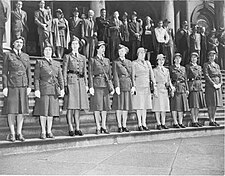 Members of the American Women Voluntary Service in 1942 during World War II Members of the American Women Voluntary Service in 1942 during World War II | |
| Formation | 1940 |
|---|---|
| Legal status | Service |
| Headquarters | 39 W. 57th Street, Manhattan, New York City |
| Region served | United States |
American Women's Voluntary Services (AWVS) was the largest American women's service organization in the United States during World War II. AWVS volunteers provided support services to help the nation during the war, assisting with message delivery, ambulance driving, selling war bonds, emergency kitchens, cycle corps drivers, dog-sled teamsters, aircraft spotters, navigation, aerial photography, fighting fires, truck driving, and canteen workers. Some of its work overlapped with the Office of Civilian Defense and the American Red Cross.
History

Alice Throckmorton McLean founded AWVS in January 1940, 23 months before the United States entered the war, basing it upon the British Women's Voluntary Services, in order to help prepare the nation for the war. Most of the founders were wealthy internationalist women, and its headquarters was in New York City, making America's isolationists suspicious of AWVS. Others saw the organization as being alarmist.
AWVS also encountered resistance because some men did not want women working. Despite these concerns, AWVS had about 18,000 members by the time of the attack on Pearl Harbor on December 7, 1941. Eventually over 325,000 women were trained by AWVS. Doris Ryer Nixon founded the California chapter in August 1941 and became AWVS's national vice president.
The group sponsored units in parts of the U.S. with heavy African, Chinese, and Hispanic American populations, which was met with media criticism. By 1944, despite hundreds of thousands of volunteers and large efforts to help win the war, AWVS was accused of being lazy; its leaders decided to disband the organization at the end of World War II.
AWVS inspired other volunteer service groups, such as "Laguna Cottages for Seniors".
Notable members
- Elizabeth English Benson, Gallaudet University dean and educator of the deaf
- Mary McLeod Bethune, educator and civil rights activist
- Clair Blank, author, Beverly Gray mystery series
- Gloria Callen, competitive swimmer
- Betty Cordon, socialite
- Joan Crawford, actress
- Mamie Eisenhower, First Lady and wife of U.S. President Dwight Eisenhower
- Isabella Greenway, U.S. Congresswoman from Arizona
- Josephine Herrick, photographer and educator
- Grace Nail Johnson, civil rights activist
- Adelaide Leavy, photo journalist
- Jeanette MacDonald, actress and singer
- Hattie McDaniel, actress
- Josephine B. Sneed, Cook County, Illinois politician
- Alice Throckmorton McLean, civic leader
- Doris Ryer Nixon, civic leader
- Lillian Randolph, actress and singer
- Betty White, actress
See also
Notes
- "Partners in Winning the War: American Women in WWII". National Women's History Museum. Archived from the original on 5 June 2011. Retrieved 8 May 2011.
- "Civilian Defense: The Ladies!". Time. 26 Jan 1942. Archived from the original on October 14, 2010. Retrieved 8 May 2011.
- ^ Weatherford, Doris (2010). American Women During WWII. New York: Taylor & Francis. pp. 21–23. ISBN 978-0-203-87066-2.
- ^ Yellin, Emily (2004). Our Mothers' War: American Women at Home and at the Front During World War II. New York: Free Press. pp. 172, 209–210. ISBN 0-7432-4516-4.
- ^ Redmond, Michael (20 Jun 2009). "Laguna Cottages History of Senior Living Housing". Santa Barbara Independent. Archived from the original on 23 May 2010. Retrieved 8 May 2011.
- "Blanche Nixon to Make Debut". Los Angeles Times. December 18, 1941. Archived from the original on June 4, 2011. Retrieved 2010-03-22.
Blanche Nixon, daughter of Mr. and Mrs. Stanhope Nixon of ... Cold Spring Road, Montecito, a freshman at Stanford, will be formally to society at the San ...
- "Social Notes," The New York Times 1922-03-23 (announcing birth) and "Died," The New York Times, 1922-05-23 (announcing death).
- Quirk, Lawrence J. (2002). Joan Crawford: the essential biography. Lexington, KY: University of Kentucky Press. p. 124. ISBN 0-8131-2254-6.
volunteer.
- "Network and Local Radio Listings". The Sunday Sun. 4 Jan 1942. Retrieved 8 Jan 2011.
- Rea, E.B. (8 May 1943). "Encores and Echoes". Baltimore Afro-American. Retrieved 8 May 2011.
External links
- Bill Guarnere site, who served with Lewis Nixon, discussion about AWVS
- History of British Women's Voluntary Service
- Smithsonian National Air and Space Museum, American Women's Voluntary Services badge
- University of North Carolina at Greensboro, American Women's Voluntary Services garrison cap, c. 1942
- University of North Carolina at Greensboro, American Women's Voluntary Services legionnaire kepi, c. 1942